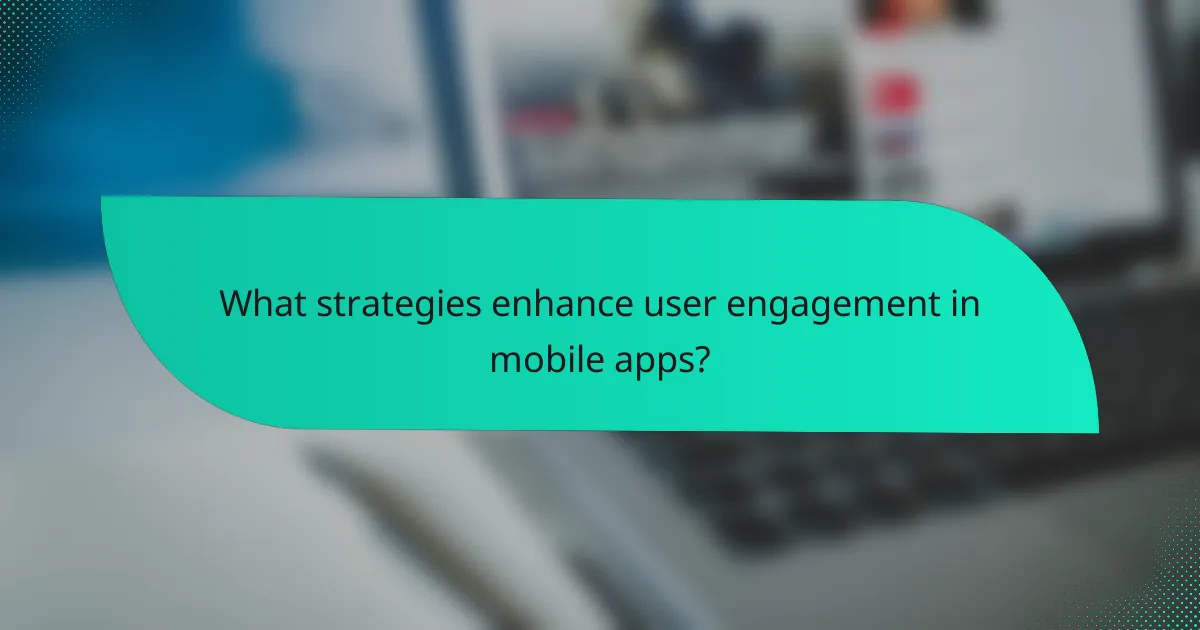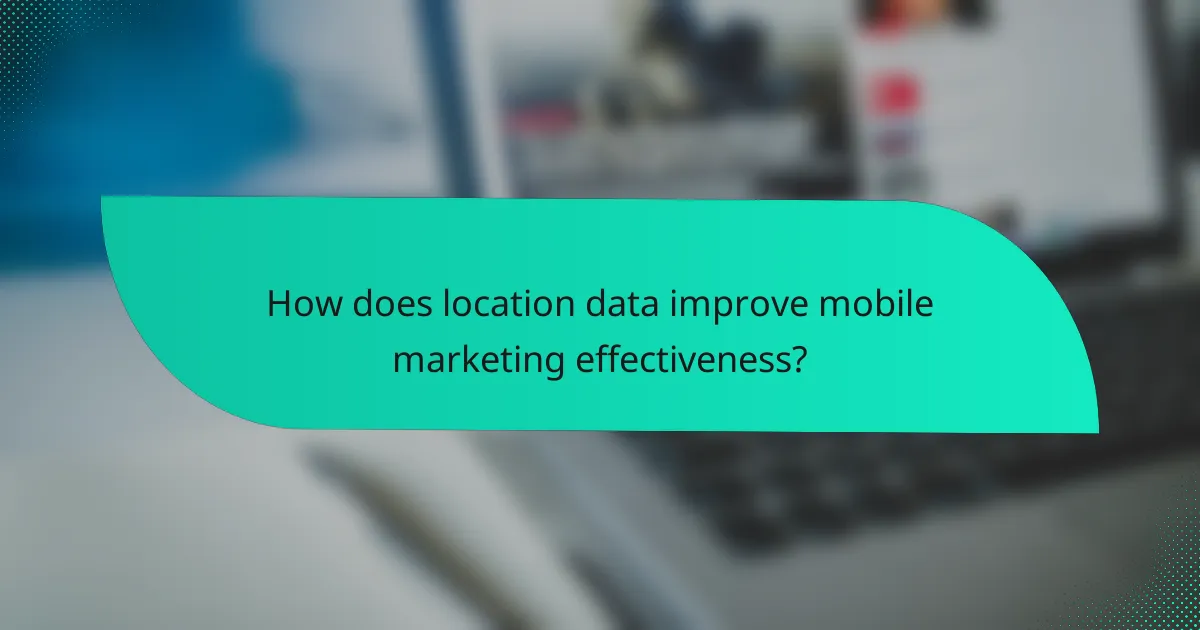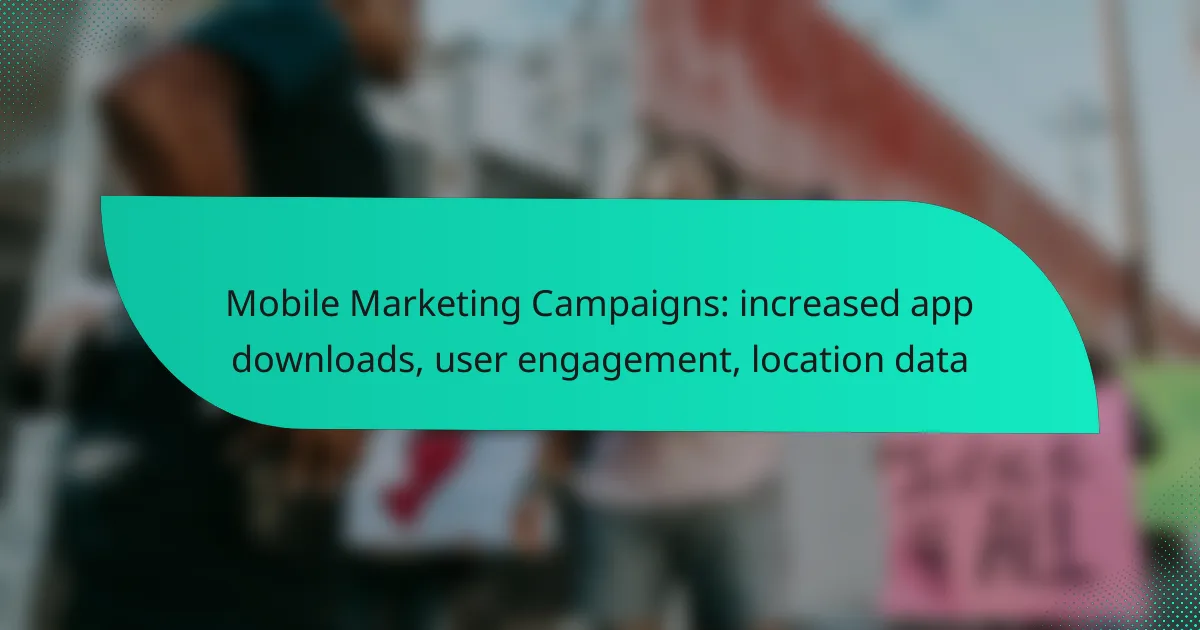Mobile marketing campaigns are essential for driving app downloads and enhancing user engagement through targeted strategies. By leveraging personalized messaging and location data, businesses can effectively reach potential users and create tailored experiences that resonate with them. This approach not only boosts visibility but also fosters ongoing interaction within the app, ultimately leading to increased retention and satisfaction.

How can mobile marketing campaigns increase app downloads in the UK?
Mobile marketing campaigns can significantly boost app downloads in the UK by utilizing targeted strategies that resonate with potential users. By focusing on personalized messaging and effective outreach methods, businesses can enhance visibility and encourage installations.
Targeted advertising on social media platforms
Targeted advertising on social media platforms like Facebook, Instagram, and TikTok allows businesses to reach specific demographics based on interests, behaviors, and location. By crafting ads that speak directly to the target audience, companies can increase the likelihood of app downloads.
Consider using A/B testing to refine ad creatives and messaging. This approach helps identify which ads perform best, optimizing the advertising budget for maximum impact.
Incentivized referral programs
Incentivized referral programs encourage existing users to share the app with friends and family by offering rewards, such as discounts or in-app bonuses. This strategy not only increases downloads but also fosters a sense of community among users.
To implement a successful referral program, clearly communicate the benefits and ensure the process is straightforward. A well-structured program can lead to a significant increase in user acquisition at a relatively low cost.
App Store Optimization (ASO) techniques
App Store Optimization (ASO) techniques enhance an app’s visibility in app stores, making it easier for users to discover and download. Key elements include optimizing the app title, description, and keywords, as well as using appealing visuals and positive user reviews.
Regularly updating the app with new features and improvements can also boost rankings in app stores. Monitoring analytics will help identify which ASO strategies yield the best results, allowing for ongoing refinement.
Influencer partnerships
Partnering with influencers can amplify an app’s reach and credibility. Influencers with a relevant audience can create authentic content that showcases the app’s features and benefits, driving their followers to download it.
When selecting influencers, consider their engagement rates and alignment with your brand values. A well-chosen partnership can lead to a substantial increase in downloads and user trust.
Localized content marketing
Localized content marketing tailors messaging and promotions to specific regions within the UK, making the app more relatable to potential users. This approach can include using local slang, cultural references, and region-specific promotions to enhance engagement.
By understanding the preferences and behaviors of different UK audiences, businesses can create targeted campaigns that resonate more deeply, ultimately leading to higher download rates.

What strategies enhance user engagement in mobile apps?
To enhance user engagement in mobile apps, strategies should focus on personalized experiences, interactive elements, and consistent communication. These approaches help retain users and encourage them to interact more frequently with the app.
Push notifications for personalized offers
Push notifications can significantly boost user engagement by delivering personalized offers directly to users’ devices. Tailoring these notifications based on user behavior and preferences increases the likelihood of interaction. For example, sending a discount offer on a user’s favorite product can prompt immediate action.
However, it’s essential to balance frequency and relevance. Overloading users with notifications can lead to app uninstalls. Aim for a targeted approach, sending notifications at optimal times based on user activity patterns.
Gamification elements
Incorporating gamification elements, such as rewards, challenges, and leaderboards, can enhance user engagement by making the app experience more enjoyable. Users are more likely to return if they feel they are progressing or competing with others. For instance, fitness apps often use points and badges to motivate users to achieve their goals.
When implementing gamification, ensure that the rewards are meaningful and achievable. This encourages users to engage without feeling overwhelmed or discouraged.
In-app messaging for user feedback
In-app messaging allows for real-time communication with users, facilitating the collection of feedback and suggestions. This direct line of communication can help identify pain points and improve user experience. For example, asking users to rate their experience after completing a task can provide valuable insights.
Be mindful of timing and context when sending messages. Avoid interrupting users during critical tasks, as this can lead to frustration. Instead, use in-app messaging during natural breaks in the user journey.
Regular content updates
Regularly updating content keeps users engaged by providing fresh and relevant information. This could include new features, articles, or seasonal promotions. For instance, a news app that updates its articles frequently will encourage users to check back often for the latest information.
Establish a content calendar to ensure updates are consistent and aligned with user interests. This approach helps maintain engagement over time and can lead to increased app usage.
Community-building features
Community-building features, such as forums or social sharing options, foster a sense of belonging among users. When users can connect with others who share similar interests, they are more likely to engage with the app regularly. For example, a cooking app that allows users to share recipes and tips can create a vibrant community.
Encourage interaction by highlighting user-generated content and facilitating discussions. This not only enhances engagement but also helps build loyalty as users feel more connected to the app and its community.

How does location data improve mobile marketing effectiveness?
Location data enhances mobile marketing by enabling targeted strategies that increase app downloads and user engagement. By understanding where users are, marketers can tailor promotions and content to meet specific needs based on geographic context.
Geotargeting for personalized promotions
Geotargeting allows marketers to send personalized promotions to users based on their current location. For example, a coffee shop app can offer a discount to users who are within a certain radius of a store, encouraging immediate visits. This targeted approach can lead to higher conversion rates compared to generic promotions.
To implement geotargeting effectively, businesses should define clear geographic boundaries and segment their audience accordingly. Utilizing GPS data and location services can help refine targeting and ensure promotions reach the right users at the right time.
Location-based analytics for user behavior
Location-based analytics provide insights into user behavior by tracking how and where users interact with an app. This data can reveal patterns, such as peak usage times in specific areas or popular features among users in different locations. Understanding these behaviors allows marketers to optimize their strategies.
Marketers should consider integrating analytics tools that can visualize location data and user interactions. Regularly reviewing this data can help identify trends and inform future marketing decisions, ensuring that campaigns remain relevant and effective.
Proximity marketing with beacons
Proximity marketing utilizes beacons to send targeted messages to users’ smartphones when they are near a physical location. For instance, retailers can use beacons to alert customers about special offers as they walk past the store. This immediate engagement can significantly boost foot traffic and sales.
To effectively use beacons, businesses should ensure that their app has the necessary permissions to access location data. Additionally, crafting compelling messages that resonate with users can enhance the effectiveness of proximity marketing efforts.
Dynamic content based on user location
Dynamic content allows marketers to customize app experiences based on a user’s location. For example, a travel app can display local attractions, weather updates, or events specific to the user’s current city. This personalization enhances user engagement and satisfaction.
To implement dynamic content, businesses should leverage APIs that provide real-time location data and relevant content. Regularly updating this content based on user feedback and changing conditions can keep the app experience fresh and engaging.
Enhanced customer journey mapping
Location data plays a crucial role in enhancing customer journey mapping by providing insights into how users move through different touchpoints. By analyzing location-based interactions, marketers can identify bottlenecks and optimize the user experience across various stages of the customer journey.
To improve journey mapping, businesses should integrate location data with customer relationship management (CRM) systems. This integration allows for a comprehensive view of user interactions, enabling marketers to tailor their strategies and improve overall customer satisfaction. Regularly revisiting and refining the customer journey based on location insights can lead to better engagement and retention rates.

What are the prerequisites for a successful mobile marketing campaign?
Successful mobile marketing campaigns require a clear understanding of the target audience, well-defined objectives, appropriate budget allocation, and the selection of suitable mobile platforms. These elements work together to enhance app downloads, boost user engagement, and effectively utilize location data.
Understanding target audience demographics
Identifying the demographics of your target audience is crucial for tailoring your mobile marketing efforts. Consider factors such as age, gender, location, and interests to create personalized content that resonates with users.
Utilizing analytics tools can help gather insights about user behavior and preferences. This data allows marketers to segment their audience and deliver targeted messages that drive higher engagement and conversion rates.
Setting clear campaign objectives
Establishing clear objectives is essential for measuring the success of your mobile marketing campaign. Objectives should be specific, measurable, achievable, relevant, and time-bound (SMART), focusing on aspects like increasing app downloads or enhancing user retention.
For example, a campaign might aim to increase app downloads by a certain percentage within a defined timeframe. Setting these goals helps in evaluating performance and adjusting strategies as needed.
Budget allocation for advertising channels
Effective budget allocation is vital for maximizing the impact of your mobile marketing campaign. Determine how much to invest in various advertising channels, such as social media, search engines, or in-app ads, based on their potential return on investment.
A common approach is to allocate a percentage of your overall marketing budget to mobile-specific channels, ensuring that you have enough resources to reach your audience effectively. Regularly review and adjust your budget based on campaign performance and market trends.
Choosing the right mobile platforms
Selecting the appropriate mobile platforms is key to reaching your target audience effectively. Consider popular platforms like iOS and Android, as well as emerging channels that may be relevant to your audience.
Evaluate the user base, engagement levels, and advertising options available on each platform. For instance, if your target demographic skews younger, platforms like TikTok or Instagram may be more effective than others. Tailoring your approach to the chosen platforms can significantly enhance campaign outcomes.

How do you measure the success of mobile marketing campaigns?
Measuring the success of mobile marketing campaigns involves tracking key performance indicators (KPIs) such as app downloads, user engagement, and location data. These metrics provide insights into how effectively your campaigns are driving user acquisition and interaction.
Increased app downloads
To measure increased app downloads, monitor the number of installations over a specific period following your marketing efforts. Use app analytics tools to track downloads from various sources, including organic searches, paid ads, and social media promotions.
Consider setting benchmarks based on historical data or industry standards. For example, a successful campaign might aim for a 20-30% increase in downloads compared to previous periods. Regularly analyze the data to identify which channels are most effective.
User engagement
User engagement can be assessed through metrics like session duration, frequency of app usage, and in-app actions. High engagement rates indicate that users find value in your app, which is crucial for retention and long-term success.
Utilize engagement metrics to refine your marketing strategies. For instance, if users are dropping off after a few sessions, consider enhancing onboarding processes or introducing new features. Aim for a retention rate of around 30-40% after the first month as a good target.
Location data
Location data can enhance your mobile marketing campaigns by allowing you to tailor content and offers based on users’ geographical locations. Tracking location data helps in understanding user behavior and preferences in different regions.
Implement geofencing strategies to send targeted notifications or promotions to users when they are near specific locations. Ensure compliance with privacy regulations, such as GDPR or CCPA, when collecting and using location data. Regularly review the effectiveness of location-based campaigns to optimize your approach.
